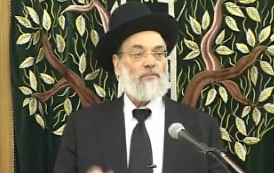Beit Midrash
- Sections
- Chemdat Yamim
- Bemare Habazak - Rabbis Questions
Answer: The gemara (Shabbat 155a) says that one may not "use," including by leaning on, a tree, as well as something that is connected or supported by a tree (e.g., a nail, rope, ladder) on Shabbat. Therefore, it is forbidden to lie on a hammock if it is tied to the tree directly; it is permitted if the hammock is attached to something connected to the tree (Shulchan Aruch, Orach Chayim 336:13). (Many hammocks come with parts in a manner that it is not obvious if it is considered one apparatus connected to the tree, or that one piece is connected to the tree and the main part of the hammock is twice removed and permitted.) Also, the lying on the hammock must not make the tree(s) move (Mishna Berura 336:63).
Hanging a tree-attached hammock, even to something already attached to the tree, will be a violation. Lying in one hung before Shabbat will depend whether the hammock is tied to the tree, or to something attached to the tree, and on the strength of the tree and weight of the person. These issues are not a problem for a hammock that is attached to a frame.
Is hanging the hammock considered making an ohel? Since a hammock is mainly horizontal, it is a candidate for ohel, which can be forbidden to erect even if it does not connect to a vertical wall (Shulchan Aruch, Orach Chayim 315:1). However, it is permitted to erect a temporary horizontal structure if it is not done to protect that which is below it unless it connects to vertical walls/boards (ibid. 3; Rama ibid. 7). A hammock connected to mere trees/poles would not have that problem.
A net-style hammock may have another reason to not have a problem of ohel. It is permitted to hang a material that has more "air" than fabric (Tosafot, Eruvin 102a; see R. Akiva Eiger, OC 315:2). This may be the case with a net fabric for a hammock, while on the other hand, the fabric of some hammocks gathers together when no one is in the hammock. In the latter case, it might be more fabric than air.

Bemare Habazak - Rabbis Questions (627)
Rabbi Daniel Mann
575 - Ask the Rabbi: When Should an Onen Recite Havdala?
576 - Ask the Rabbi: Hanging and Using Hammocks on Shabbat
577 - Ask the Rabbi: Things that End the Meal and Ramifications
Load More
Still, we cannot give broad permission to hang hammocks on Shabbat because the potential of other problems exists. In some models, there is a need or a likelihood of tying forbidden knots. Attaching the hammock to different types of frames can potentially be forbidden due to boneh or tikkun kli (different forms of forbidden building). Various parameters determine when an attachment is forbidden, and some of the major factors are: the connection’s strength, the expected or standard duration of the connection, and whether it is attached to something that is attached to the ground (see our Ask the Rabbi column for Va’ethchanan 5784). These can depend on the model and on how an individual makes and uses it. We would therefore expect someone (unless he is capable of working out the halachic calculations of his specific case) to put up the hammock before Shabbat if he will want to use it. It will then be permitted to use it in most cases (as we explained above).

Ask the Rabbi: Beracha when Lighting for a Neighbor
Rabbi Daniel Mann | Kislev 5786

Ask the Rabbi: Ice Cream on Hot Cake on Shabbat
Rabbi Daniel Mann | Iyar 5785

Ask the Rabbi: Giving Ma’asrot to the Intended Recipients
Rabbi Daniel Mann | Av 5785

Ask the Rabbi: Sacrificing Davening to be the Tenth Man
Rabbi Daniel Mann | Sivan 5785

Rabbi Daniel Mann

Davening Early on Shavuot
Iyar 26 5777

Obtaining Arba’ah Minim for the Sukkot after Shemitta
Tisheri 7 5776

Tazria Metzora Question
5772























